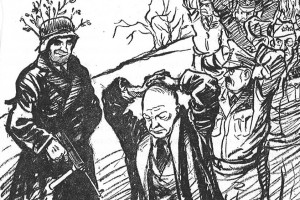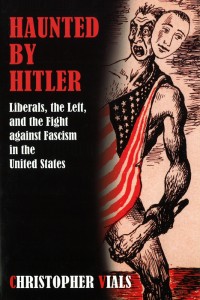After World War II, many Americans thought the defeat of the Axis Powers of Germany, Italy, and Japan signaled the end of the threat of fascism, the political ideology based in extreme right-wing nationalism.
Yet fascist ideology existed in the United States in the early part of the 20th century; and in a new book Christopher Vials, director of American Studies and an associate professor of English, examines how fascism continues to lurk in the fabric of the nation’s culture and politics.
“There are functional equivalents of fascism in the United States after World War II, and these have had a demonstrable effect on American culture,” says Vials, author of Haunted by Hitler: Liberals, the Left, and the Fight against Fascism in the United States (University of Massachusetts Press 2014). “I’m not saying they take the forms of Mussolini and Hitler. There is a distinctly American vein. The biggest aim of the book is to begin to have a conversation about the history of fascism within the United States.”
Vials, whose previous book (Realism for the Masses: Aesthetics, Popular Front Pluralism, and U. S. Culture, 1935-1947, University Press of Mississippi 2009) examined American culture in the 1930s and 1940s, says that throughout American history there have been fringe movements that are important because they “terrorize people;” but he is most concerned about “functional equivalents of a mainstream fascist movement in the United States.”
He notes how American politics has been affected by such activities in the past, from the 1930s radio broadcasts of Father Charles Coughlin – considered the founding father of right-wing radio – to George Wallace’s American Independent Party in the 1960s, and beyond.

The Independent Party, the party of the Alabama governor known for his segregationist stand in his run for President in 1968, tried to capitalize on white backlash against minorities – a politics of resentment – which Vials says subsequently served as a strategy for Republican Party politics that was used by Richard Nixon, Ronald Reagan, and George H.W. Bush. It was this political approach that led the Black Panther Party to label the tactics used by the United States government as fascist during demands from minority groups for social justice.
“What the Panthers were identifying at the time through the horrific backlash toward people of color movements in the late 1960s and the mainstreaming of Wallace was a kind of fascist politics,” Vials says. “These politics were toxic not just for African Americans and people of color, but for white people as well.”
He says that in the contemporary United States, the Christian Right, particularly certain strands of it, are the closest functional equivalents of a mainstream fascist movement in the United States. But there are also some who apply the term to liberals.
“You have books like Jonah Goldberg’s Liberal Fascism making a serious argument that liberals in the United States from John F. Kennedy to Hillary Clinton are fascists,” Vials says. “It’s become this relativizing term that embraces everything. In certain ways the left, with its own hyperbolizing, has been responsible for that state of affairs.”
While Vials is more cautious in applying the term fascist, he says he does identify a movement like the Tea Party as dangerous. “Even though it’s premature to call it fascist per se, they do have to explain someone like Richard Iott, who was running for U.S. Congress as a Tea Party representative and who dressed up like a Nazi, and others like him who are drawn to their movement,” he says. “There’s a reason for that; they recognize in the Tea Party a common set of core beliefs and a kind of exclusionary nationalism that they can latch themselves onto.”
Vials explains that the two symbols of World War II fascism, Adolph Hitler and Benito Mussolini, built their political philosophy on the central role of militarism, after embracing military culture during their service in World War I and seeking to recreate society based on military life.
“Anti-fascists in the 1950s were concerned with the rise of the military industrial complex and about the Cold War,” he says. “With the permanent standing army you get after the Korean War and with a permanent militarization of the culture, there really is a cause for concern. If you get a politics that is foundationally tied to militarism and yokes that militarism in particular ways, it’s a bad sign.
“I’m not saying that any politicians who are ex-military are fascists, but if you have a war hero politician who is into military expansion abroad and who wants to refashion civilian life around the model of the military – and combines this with fanatical anti-communism and racism – all of these things combined should raise the alarm bells. But this is only one form an American fascism can take.”




